Baptist Church
Parkside
J.E. Dodd 1913, 2 manuals, 14 speaking stops, mechanical action
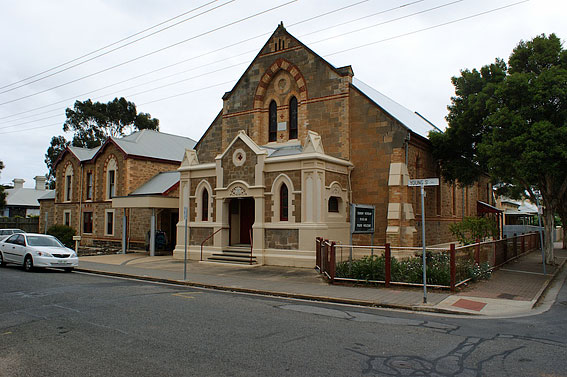
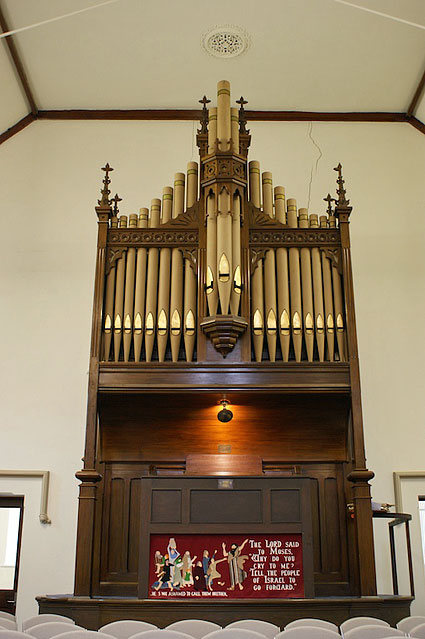
Notes by Rev Bruce Naylor "Celebrating 150 years since the birth of J E Dodd" (Aug. 2006):
Seventeen years have passed since Dodd built his first organ for St Bartholomew's Church, Norwood. The first organ was traditional, this instrument reflects Dodd's orchestral concept of an organ. Higher wind pressure, and pipe scales, no real attempt at a chorus with stops selected for their orchestral colour and solo effects.
Builder: J.E. Dodd 1913. In memory of J.W. Coudrey. Memorial plaque. Cost £200. [1]
| Great organ 1 Open diapason 2 Claribel 3 Salicional 4 Octave 5 Flauto traverso 6 Clarinet i Swell to Great ii Swell to Great sub iii Swell to Great super Swell organ 7 Open diapason 8 Hohl Flute 9 Dolce 10 Viol d'orchestre 11 Dulcet 12 Cornopean Pedal organ 14 Bourdon iv Swell to Pedal v Great to Pedal |
8 8 8 4 4 8 8 8 8 8 4 8 16 |
6 stops prepared for prepared for 7 stops prepared for 1 stop |
Compass: 58/30
Wood and metal pipes
tracker action
slider soundboards
toe pedals - Great 2, Swell 2
trigger tremulant
balanced Swell (side) pedal
attached console
drawknobs
free standing pulpit
excellent acoustics
wind pressure 3"
1. Dodd, J.E., Ledger, 1908, 146.
From the 2009 OHTA Conference Book, David Shield writes:
Mr and Mrs Coudrey had much to do
with the foundation of the Baptist cause in Parkside. James Coudrey had been owner of a pig-iron foundry in
Staffordshire but, with a slump in the industry migrated to Adelaide in 1879
bringing his wife, family and in-laws with him.1 Supposedly stemming from a conversation
between Mrs Coudrey and a Mr John Foreman late in 1879, a circular dated 26
March 1880 called a meeting in the vestry of Flinders Street Baptist Church for
the establishment of a Baptist interest in the rapidly growing suburb of
Parkside. During 1879, 100 new
dwellings had been erected in Eastwood and Parkside.2
The first meeting was held on 30 March 1880 and a committee formed. Decisions were taken to buy land and invite the Revd S. Fairey to be first pastor. C.H. Goode immediately acquired an option on the land on which the church now stands. By 22 April the first plans for a building had been drawn by Mr James Cumming, architect, of Currie St, tenders were then called and a contract let on 3 June to Mr Thomas Gidley with Mr A. McMillan as clerk of works. Services were first conducted in the Coudrey’s home, Young Street, on the first Sunday in August 1880. By September, the vestry was complete, and services were held there until the church was opened for worship on 5 December 1880, nine months and five days from the time of the meeting of the first committee.3
Cumming designed the building to accommodate 400 people. In Gothic style, it was constructed using freestone, relieved with bands and voussoirs (wedge shaped stones) of white and red bricks, and the weatherings and copings of cemented work. The nave was 63ft x 37ft and 27ft (19.2m x 11.3m x 8.2m) high at the platform, containing a baptistery at one end. Ventilation (essential for the South Australian climate) was provided by the windows, and flowers in the ceiling communicating with dormers in the roof. A room behind the nave was to be divided into three vestry rooms.4
In recent years, along with physical changes to the building, the orientation of worship has been altered. With the replacement of pews by chairs the congregation now faces the Eastern wall. The Sunday School building of 1883 has been joined to the main building and a new entrance created by which the congregation enters. The memorial porch is now used for other purposes.
The Coudreys brought a small portable organ with them from England. This instrument, along with another owned by D.W. Melvin,5 was lent to the church during the first two years prior to the purchase of a reed organ for £40 in 1883. With Mr H. Hassell assisting on cello, this was used till the pipe organ was acquired in 1913.6 Whether the borrowed instruments were pipe organs is not clear though it is more likely they were reed organs. It is interesting to note that an organ said to have been built by Coudrey in 1894, is currently in the Echunga Uniting Church.7 For the opening services of the church Mr E Thorpe lent his organ. Joseph Coudrey became the first secretary and was the first organist. He campaigned for many years to obtain a pipe organ but died in 1908. The organ built by J.E. Dodd was opened with a concert on 22 January 1913 and was dedicated to Coudrey’s memory.
Exactly when negotiations began for the organ is unclear. The Church must have entered a provisional agreement for the construction of an instrument to cost £300. A more formal agreement was written dated 20 May 1912 including the specifications for a two-manual organ, details of construction, and a guarantee that it would be “erected and completed and ready for use in the Church on the seventeenth day of December 1912”. However, the cost was to be £375.
In the covering letter four days later, Eustace Dodd apologised for exceeding the church limit, indicated ways of reducing cost, and tried to get the organ made at the higher price by using a subtle form of bribery. In his opinion it was the smallest instrument that could meet their needs and blamed the type of case design for the additional cost. To reduce costs he suggested the prepared stops might not be proceeded with at a saving of £16, but warned against it. Removing the super octave on the swell would save £10 and the Dolce on the Pedals a further £12.10.0. He then suggested that if the Church could not see its way clear to incorporate the enlarged scheme it might be best to leave things in abeyance to a more opportune time. Then comes the twist and Dodd uses the death of Coudrey as a lever. “I’m sure the late revered gentleman whose memory you intend to perpetuate by this organ , would be the first to say that it be temporarily shelved, rather than … it should not worthily fulfil its true position in your midst, and be a source of increasing inspiration.” Dodd thanks them for the provisional order and if there was any suspicion of his using it as a lever to force their hands and pay more than they wished, was prepared to free them of their obligation. As a final point he indicates that “the contract appeals to me especially owing to the long standing, and greatly esteemed friendship existing between the late Mr Coudrey and my father, and on this score alone, I should like to do my very utmost to produce a memorial, worthy of this gentleman.”8 How could they resist?
Five months later the issue of the organ’s motive power was raised. Dodd favoured the hydraulic engine wherever possible but indicated that it was subject to the pressure of the water. As this was low in Parkside he offered an electric motor and blower at an additional cost of £80. Savings could be made if installed at the same time as the organ and he used the organ at the Wesleyan Church in Norwood as an example for comparison. The immediate response was for the church to stay with manual blowing.9
The guarantee of completion by mid-December was to be unfulfilled. Although the original agreement had indicated 17 December, Dodd wrote on the second of that month that he could not promise completion of the organ before 31 December. He reiterated his reasons for the delay as the result of the “unsettled condition of the labour market” and the impossibility of getting further effort out of his staff in the way of overtime.10 The organ committee responded by fixing the date for the opening for 22 January 1913.
As was his custom, Dodd offered to organise the opening services for the organ. Without consulting the church, and before the completion date of the organ had been determined, he had contacted Wilfred Arlom LRCM ARCM to undertake the task.11 He rationalised that he was in a better position to undertake the arrangements for the recital as “I am more advantageously placed in arranging such matters than the average church, where a Professional Organist is not permanently retained”. But his offer did not extend to the cost of supplying printing of programmes.12
By inference it would seem the visibility of the organ blower was a distraction. In a reply to the organ committee secretary, Mr O.H. Walter, the reconstruction of the bellows action, to be operated from behind the organ rather than the side, was discussed. Dodd was “always absolutely against placing a blower where he practically speaking had a free hand, and where he is not under the direct eye of some responsible person”. He felt the £10 needed to penetrate the back wall would be better spent completing the organ. He suggested a screen be erected instead, and sighted the “very select” Church of the Epiphany Crafers as an example where none of the congregation had “taken exception to the blower being seen while operating the handle”.
Dodd’s reasons make interesting reading:
The trouble in placing a blower away from the direct control of the organist, and not in touch with some, at least of the members of the Congregation, is that he frequently takes advantage of his position to leave the building, during sermon etc., and, when wind is afterwards required, he is absent from his post. There is a further disadvantage that he often invites his friends round to join him, and a natural consequence is that much talk and giggling takes place which is not generally considered to add to the dignity of the service, and also only too often, the blower’s surroundings are adorned by drawings, writings, and carvings of a decidedly objectionable character.13
Acting on his own initiative Dodd found a buyer for the cabinet organ used from 1883. He sold it to Mr D. Fraser of Black Forest for £17. After deducting £3 for renovating, tuning, and transporting the organ, he offered the Church a credit note of £14 and asked for their approval of his actions.14
The specification as offered in the original agreement follows. The case was to be made of New Zealand Rimu timber and stained and polished to a dull walnut finish. The organ was to be tuned to New Philharmonic Pitch = 522 ½ vibrations at 65o . The whole of the organ was to be voiced on 3½” wind pressure.
S
P E C I F I C A T I O N.
TWO MANUAL PIPE ORGAN
BAPTIST
CHURCH, YOUNG STREET, PARKSIDE.
--by--
J. E. D O D D,
Adelaide, London, Perth, & Auckland.
GREAT ORGAN of 6 STOPS: COMPASS CC to a'", 58 NOTES.
|
1.
|
OPEN DIAPASON
|
metal
|
8 ft.
|
|
2.
|
CLARIBEL
|
wood
|
8 ft.
|
|
3.
|
SALICIONAL
|
metal
|
8 ft.
|
|
4.
|
OCTAVE
|
metal
|
4 ft.
|
|
5.
|
WALD FLUTE*
|
wood
|
4 ft.
|
|
6.
|
CLARINET*
|
metal
|
8 ft.
|
SWELL ORGAN of 7 STOPS: COMPASS CC to a'", 58 NOTES.
|
7.
|
GEIGEN DIAPASON*
|
metal
|
8 ft.
|
|
8.
|
HOHL FLUTE
|
wood
|
8 ft.
|
|
9.
|
VIOLE D'ORCHESTRE
|
metal
|
8 ft.
|
|
10.
|
DULCET
|
metal
|
4 ft.
|
|
11.
|
CORNOPEAN*
|
metal
|
8 ft.
|
|
12.
|
OBOE*
|
metal
|
8 ft.
|
|
13.
|
TREMULANT
|
|
|
PEDAL ORGAN of 2 STOPS: COMPASS CCC to f', 30 NOTES.
| 14. | BOURDON | wood | 16 ft. |
| 15. | DOLCE | metal | 8 ft.
|
|
|
|||
C O U P L E R S
|
16. GREAT
to PEDAL 17.
SWELL to PEDAL
|
|
18. SWELL
to GREAT 19.
SWELL SUPER OCTAVE
|
|
20. SWELL SUB OCTAVE
|
COMPOSITION PEDAL MOVEMENTS.
1. Great Organ "piano" 2. Great Organ "forte"
Balanced
Swell Crescendo Pedal
3. Swell
Organ "piano" 4. Swell Organ "forte"
O R G A N B E N C H
ORGAN WORKS,
GAWLER PLACE, ADELAIDE.
20th. May, 1912.
N.B. The Stops marked with an asterisk (*) indicate those that it is proposed to prepare for only. In these stops the Sound Board Action, Drawstop Action, Bellows and everything shall be provided with the exception of the actual pipes and the fitting of same in. D.E.D.
Note DLB refers to a number of Dodd Letter Books in the possession of George Stephens as transcribed by OHTA.
________________________________________________________________________________________
1 The group included Kate Hill, sister of Coudrey’s wife Emily
Louisa, nee Hill. Orphaned early
Kate lived with the Coudrey’s.
Alice Tibbits, her friend, also emigrated, the pair becoming authorities
in the training of nurses and hospital management. Gibberd J, “Kate Hill”, article in Australian Dictionary of
Biography online: http://www.adb.online.anu.edu.au/biogs/A090302b.htm
2 Jensen, E. & R., Colonial Architecture in South Australia (Adelaide: Rigby, 1980), p.671; note 9/780 - Register, 2 January 1880
3 Parkside Baptist Church Jubilee Souvenir 1880-1930
4 Observer, 11 December 1880, p.997.4
5 D.W. Melvin was a draper, sub editor for the Register, and auctioneer. A staunch supporter of the Baptist cause he was one of the first to donate to the Parkside Baptist Building fund (research notes D. Shield)
6 Parkside Baptist Church: Jubilee Souvenir 1880-1930
7 Town & Gown: OHTA Conference booklet 1999, p.38. As Coudrey’s daughter was organist at Parkside Baptist for some years it is likely the organ remained in the home until 1966 when it was acquired by Rosewater Methodist Church. Dora died in 1969 aged 83. It may have been this instrument that formed Coudrey’s relationship with Dodd; see DLB 1910-1912, 24 May 1913
8 Eustace Dodd to The Organ Committee Baptist Church Parkside; ibid., pp.870-873 (some duplication in original) on pp.874-877 (p.875 missing)
9 Dodd to Oscar H. Walter, 11 October 1912: DLB 1909-1914 pp.92-94
10 Dodd to Organ Committee, 2 December 1912, DLB 1909-13, pp.852-853
11 Ibid.; Arlom opened the organ for the Victoria Square Methodist Church Kadina in September of 1911 - Kadina and Wallaroo Times, 2 September 1911, p. 2.4
12 Dodd to Oscar H Walter, 13 December 1912: DLB 1909-13, pp.887-888
13 Ibid. 7 February 1913 in response to a letter on 5th inst: DLB 1909-13, p.909
14 Ibid. 30 September 1913: DLB 1913-16, p.12
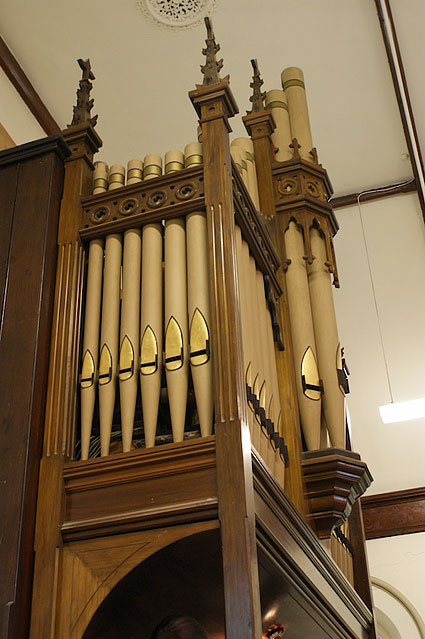

Photos: Rodney Ford (Oct 2009)

Photo: JRM (Oct 2009)

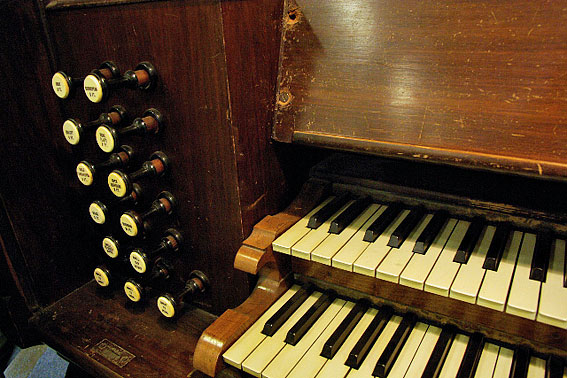
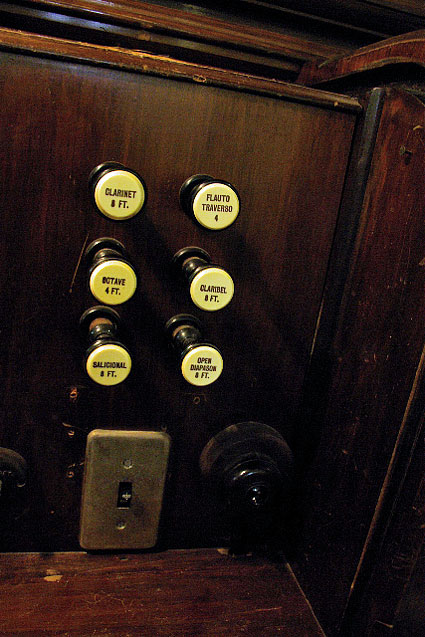
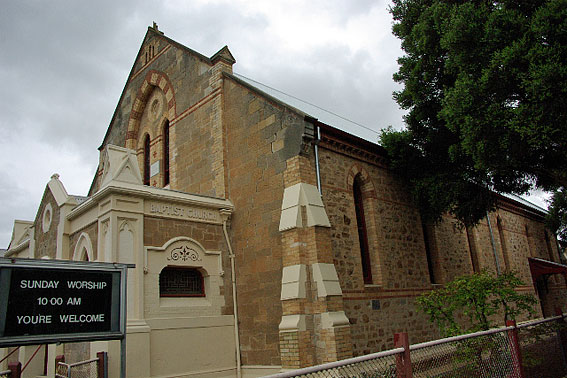
Four photos above: PdL (Oct 2009)